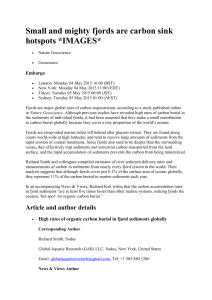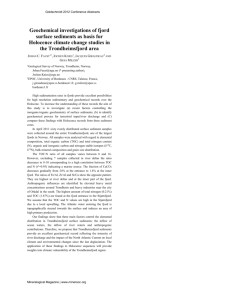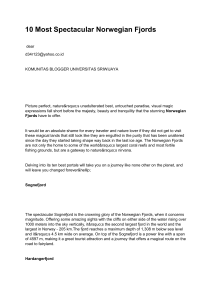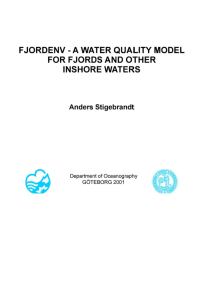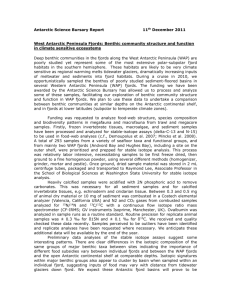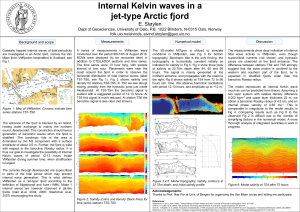Fjords
advertisement
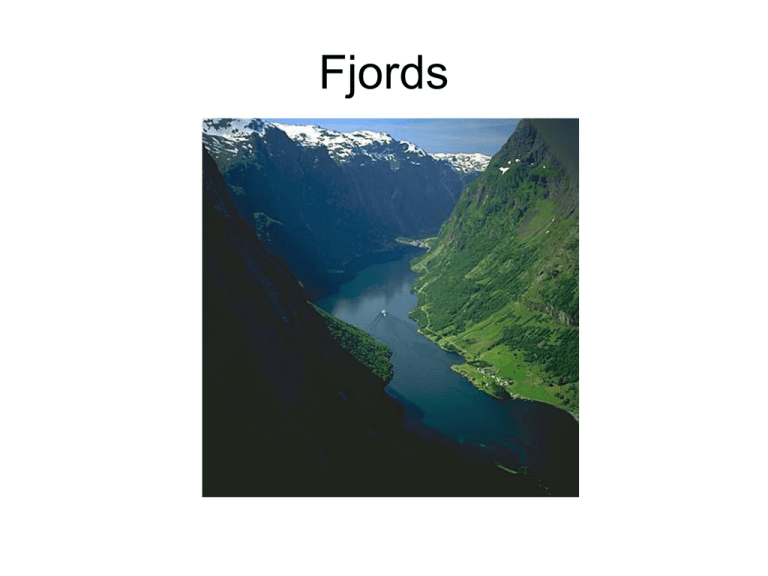
Fjords Distribution • Fjords formed by glaciers, consequently occur at high latitudes • Northern hemisphere: Canada, USA (one fjord), Norway, Island, Greenland, Scotland, Sweden (one fjord) • Southern hemisphere: Chile, New Zealand Topography • Outer sill, sill depth and area at opening essential for exchange with outer waters • Polls, very shallow sill • Fjords are deep; depth more important characteristics than supply of freshwater • Sognefjorden 1300 m Sketch fjord Transport (advection) • • • • Estuarine circulation Exchange intermeditate layer Deep water renewals Tidal exchange Estuarine circulation • Supply of freshwater gives surplus of water which runs out of the estuary/fjord • Mixes with salt water, so that volume of outgoing water increases, including outwards transport of salt water • Results in an ingoing, compensation current of salt water Example estuarine circulation; experiment with hydroelectric power plant Biological implication: brackish water plankton Oceanic fauna In this situation estuarine circulation important, but text books often give a misleading picture of its importance in fjords • Fjords are deep, and only a thin, upper layer impacted by freshwater (though the most productive vertical strata) • The ”engine” in ES generally to weak compared to other current systems Exchange in the intermediate layer may be very important • Exchange between fjord and outer coastal waters, beneath the brackish layer, but above sill depth • Importance of exchange in the intermediate layer increases by depth and area at fjord opening Deep water/oxygen Fish and krill in hypoxic waters Bunnefjorden • Oxygen reduced at depth, but still normally sufficient oxygen also in the deep basin water (basin water = beneath sill depth) • Gradual dilution of deep water over time due to mixing with upper layers, make the deep water less dense • Replacement of the deep water when water at (above) sill depth outside the fjord higher density than basin water within the fjord • Deep water renewals often during winter, due to temperature, salinity (at sill depth) and wind conditions • Frequencies of renewals varies among fjords Nordfjord, many years between renewals, still no oxygen deficiency at 400 m depth Fjords of limited vaule for fisheries • Aquaculture • Sprat • Overwintering herring Fauna • The fauna in fjords simlar to coastal and oceanic fauna, no praticular fjord fauna • The depth of fjords very important; large depth facilitates presence of deep-sea (mesopelagic) species otherwise only found in the open ocean • Fjords with different optical properties have different fauna Benthosema glaciale Periphylla periphylla Fjords as model systems • Fjords can be used as model systems for oceans • Easy access to organisms which otherwise only can be studied at large depths offshore • Inexpensive, simple logistics • Examples: mortality overwintering Calanus exposed to different types of predators, the ecology of krill, mesopelagic fish, deep sea jellyfish
